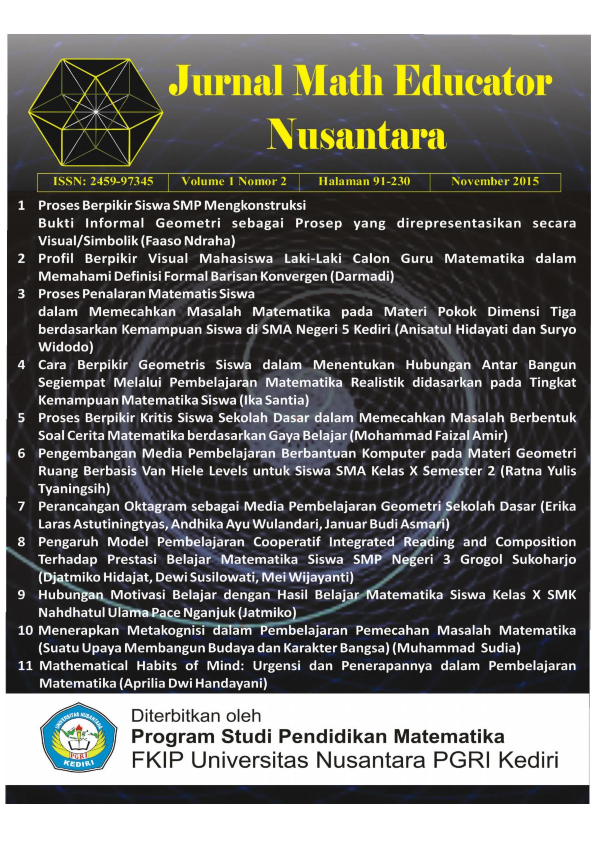PERANCANGAN OKTAGRAM SEBAGAI MEDIA PEMBELAJARAN GEOMETRI SEKOLAH DASAR
DOI:
https://doi.org/10.29407/jmen.v1i2.234Abstract
Abstract:This study aims to determine: (1) Octagrams development with ADDIE models, (3)which havea better mathematics achievement in Geometry, who teachuses Octagram or the ones withtraditional approach.This study is a research and development of Octagramuses ADDIE(Analysis, Design, Development, Implementation, and Evaluation) method. This study islimited on development. The instruments used are a mathematics achievement test,students questionnaire, and validity questionnaire. Qualitative data analysis used aredatastudy,data reduction, and conclution. Mathematics achievement analysis uses t-test. The testrequirements include a population with normality of the Liliefors test, test of homogeneity ofvariance. Based on the results of study, it can be concluded that (1) development ofOctagram with ADDIE models in Geometry lesson consist of three steps. Analysis is todeterminewhat kinds of development will do. Design is construct draftof Octagram.Development are validate instrument by expert judgement and limited desemination, (2) Theuses of Octagramin Graph Theory lecture gives a better mathematics achievement thanthetraditional approach.Keywords : Octagram, ADDIE, Geometry
Abstract views: 259 , PDF (Indonesian) downloads: 225
Downloads
Published
2015-11-04
Issue
Section
Artikel
License
Authors who publish with this journal agree to the following terms:
- Copyright on any article is retained by the author(s).
- The author grants the journal, the right of first publication with the work simultaneously licensed under a Creative Commons Attribution License that allows others to share the work with an acknowledgment of the work’s authorship and initial publication in this journal.
- Authors are able to enter into separate, additional contractual arrangements for the non-exclusive distribution of the journal’s published version of the work (e.g., post it to an institutional repository or publish it in a book), with an acknowledgment of its initial publication in this journal.
- Authors are permitted and encouraged to post their work online (e.g., in institutional repositories or on their website) prior to and during the submission process, as it can lead to productive exchanges, as well as earlier and greater citation of published work.
- The article and any associated published material is distributed under the Creative Commons Attribution-ShareAlike 4.0 International License
How to Cite
Astuningtyas, E. L. (2015). PERANCANGAN OKTAGRAM SEBAGAI MEDIA PEMBELAJARAN GEOMETRI SEKOLAH DASAR. Jurnal Math Educator Nusantara: Wahana Publikasi Karya Tulis Ilmiah Di Bidang Pendidikan Matematika, 1(2). https://doi.org/10.29407/jmen.v1i2.234
















